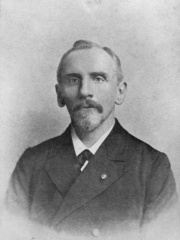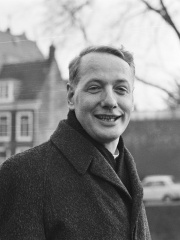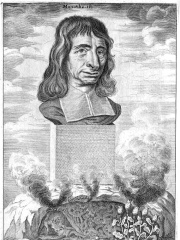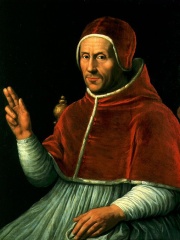

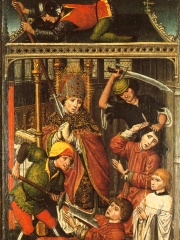
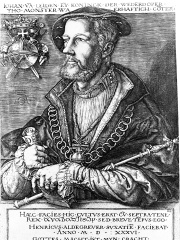
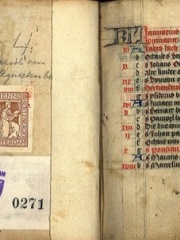
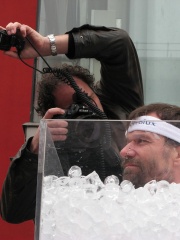
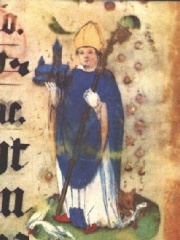
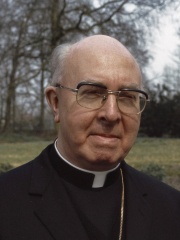
The Most Famous
RELIGIOUS FIGURES from Netherlands
This page contains a list of the greatest Dutch Religious Figures. The pantheon dataset contains 2,238 Religious Figures, 17 of which were born in Netherlands. This makes Netherlands the birth place of the 29th most number of Religious Figures behind Lebanon and Czechia.
Top 10
The following people are considered by Pantheon to be the top 10 most legendary Dutch Religious Figures of all time. This list of famous Dutch Religious Figures is sorted by HPI (Historical Popularity Index), a metric that aggregates information on a biography’s online popularity. Visit the rankings page to view the entire list of Dutch Religious Figures.

1. Pope Adrian VI (1459 - 1523)
With an HPI of 73.09, Pope Adrian VI is the most famous Dutch Religious Figure. His biography has been translated into 73 different languages on wikipedia.
Pope Adrian VI (Latin: Hadrianus VI; Italian: Adriano VI; German: Hadrian VI.; Dutch: Adrianus/Adriaan VI), born Adriaan Florensz Boeyens (2 March 1459 – 14 September 1523), was head of the Catholic Church and ruler of the Papal States from 9 January 1522 until his death on 14 September 1523. The only Dutchman to become pope, he was the last non-Italian pope until the Polish John Paul II 455 years later. Born in the Episcopal principality of Utrecht of the Holy Roman Empire of the German Nation, Adrian studied at the University of Leuven in the Low Countries, where he rose to the position of professor of theology, also serving as its rector (the equivalent of president or vice-chancellor). In 1507, he became the tutor of the future Holy Roman Emperor Charles V, who later trusted him as both his emissary and his regent. In 1516, Charles, now King of Castile and Aragon, appointed Adrian bishop of Tortosa, Spain, and soon thereafter Grand Inquisitor of the kingdoms of Aragon and Castile. Pope Leo X made him a cardinal in 1517 and after Leo's death he was elected pope in 1522 as a compromise candidate. Adrian came to the papacy in the midst of one of its greatest crises, threatened not only by Lutheranism to the north but also by the advance of the Ottoman Turks to the east. He refused to compromise with Lutheranism theologically, demanding Luther's condemnation as a heretic. However, he is noted for having attempted to reform the Catholic Church administration in response to the Protestant Reformation. Adrian's admission that the Roman Curia itself was at fault for the turmoil in the Church was read at the 1522–1523 Diet of Nuremberg. His efforts at reform, however, proved fruitless, as they were resisted by most of his contemporaries, and he did not live long enough to see his efforts through to their conclusion. He was succeeded by the second Medici pope, Clement VII. Adrian VI and Marcellus II are the only popes of the modern era to retain their baptismal names after their election. Adrian VI is the last pope to date to take on the pontifical name "Adrian".

2. Menno Simons (1496 - 1561)
With an HPI of 62.64, Menno Simons is the 2nd most famous Dutch Religious Figure. His biography has been translated into 35 different languages.
Menno Simons (1496 – 31 January 1561) was a Roman Catholic priest from the Friesland region of the Low Countries who was excommunicated from the Catholic Church and became an influential Anabaptist religious leader. Simons was a contemporary of the Protestant Reformers and it is from his name that his followers became known as Mennonites. "Menno Simons" (Dutch: [ˈmɛnoː ˈsimɔns]) is the Dutch version of his name; the Frisian version is Minne Simens (West Frisian: [ˈmɪnə ˈsimn̩s]), the possessive "s" creating a patronym meaning "Minne, son of Simen" (cf. English family names like Williams and Rogers).

3. Lambert of Maastricht (635 - 705)
With an HPI of 59.70, Lambert of Maastricht is the 3rd most famous Dutch Religious Figure. His biography has been translated into 20 different languages.
Lambert of Maastricht, commonly referred to as Saint Lambert (Latin: Lambertus; Middle Dutch: Sint-Lambrecht; Limburgish: Lambaer, Baer, Bert(us); c. 636 – c. 705), was the bishop of Maastricht-Liège (Tongeren) from about 670 until his death. Lambert denounced Pepin's liaison with his mistress or bigamous wife Alpaida, the mother of Charles Martel. The bishop was murdered during the political turmoil that developed when various families fought for influence as the Merovingian dynasty gave way to the Carolingians. He is considered a martyr for his defence of marriage. His feast day is September 17.

4. John of Leiden (1509 - 1536)
With an HPI of 59.53, John of Leiden is the 4th most famous Dutch Religious Figure. His biography has been translated into 23 different languages.
John of Leiden (born Johan Beukelszoon; 2 February 1509 – 22 January 1536) was a Dutch Anabaptist leader. In 1533 he moved to Münster, capital of the Prince-Bishopric of Münster, where he became an influential prophet, turned the city into a millenarian Anabaptist theocracy, and proclaimed himself King of New Jerusalem in September 1534. The insurrection was suppressed in June 1535 after Prince-Bishop Franz von Waldeck besieged the city and captured John. John was tortured to death in the city's central marketplace on 22 January 1536, along with Bernhard Knipperdolling and Bernhard Krechting.
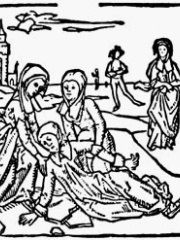
5. Lidwina (1380 - 1433)
With an HPI of 57.05, Lidwina is the 5th most famous Dutch Religious Figure. Her biography has been translated into 20 different languages.
Lidwina (Lydwine, Lydwid, Lidwid, Liduina of Schiedam) (1380–1433) was a Dutch mystic who is honored as a saint by the Catholic Church. She is the patroness saint of the town of Schiedam, of chronic pain, and of ice skating. Lidwina is also thought to be one of the first documented cases of multiple sclerosis. At the age of fifteen, she suffered a serious injury while ice skating and became progressively disabled. Hendrik Mande wrote for her consolation a pious tract in Dutch. She fasted frequently and acquired a reputation as a healer and holy woman. Upon her death in 1433, her grave became a place of pilgrimage.

6. Geert Groote (1340 - 1384)
With an HPI of 56.75, Geert Groote is the 6th most famous Dutch Religious Figure. His biography has been translated into 21 different languages.
Gerard Groote (October 1340 – 20 August 1384), otherwise Gerrit or Gerhard Groet, in Latin Gerardus Magnus, was a Dutch Catholic deacon, who was a popular preacher and the founder of the Brethren of the Common Life. He was a key figure in the Devotio Moderna movement.

7. Wim Hof (1959 - )
With an HPI of 56.15, Wim Hof is the 7th most famous Dutch Religious Figure. His biography has been translated into 26 different languages.
Wim Hof ([ʋɪm ɦɔf]; born 20 April 1959), also known as The Iceman, is a Dutch motivational speaker and extreme athlete noted for his ability to withstand low temperatures. He previously held a Guinness World Record for swimming under ice and prolonged full-body contact with ice, and he holds a record for a barefoot half marathon on ice and snow. He attributes these feats to his Wim Hof Method (WHM), a combination of frequent cold exposure, breathing techniques and meditation. Hof's method has been the subject of several scientific studies, with mixed results.

8. Ludger (742 - 809)
With an HPI of 54.99, Ludger is the 8th most famous Dutch Religious Figure. His biography has been translated into 18 different languages.
Ludger (Latin: Ludgerus; also Lüdiger or Liudger) (born at Zuilen near Utrecht c. 742; died 26 March 809 at Billerbeck) was a missionary among the Frisians and Saxons, founder of Werden Abbey and the first Bishop of Münster in Westphalia. He has been called the "Apostle of Saxony".

9. Johannes Willebrands (1909 - 2006)
With an HPI of 52.65, Johannes Willebrands is the 9th most famous Dutch Religious Figure. His biography has been translated into 17 different languages.
Johannes Gerardus Maria Willebrands (4 September 1909 in Bovenkarspel, North Holland – 1 August 2006) was a Dutch Cardinal of the Roman Catholic Church. He served as President of the Pontifical Council for Promoting Christian Unity from 1969 to 1989, and Archbishop of Utrecht from 1975 to 1983. Elevated to the cardinalate in 1969, Willebrands was central to the increased ecumenism of the Church in the second half of the 20th century, and was considered papabile at the two conclaves held in 1978.
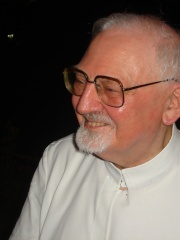
10. Peter Hans Kolvenbach (1928 - 2016)
With an HPI of 52.43, Peter Hans Kolvenbach is the 10th most famous Dutch Religious Figure. His biography has been translated into 22 different languages.
Peter Hans Kolvenbach (30 November 1928 – 26 November 2016) was a Dutch Jesuit priest and professor who was the 29th superior general of the Society of Jesus, the largest male Catholic religious order.
Pantheon has 17 people classified as religious figures born between 635 and 1959. Of these 17, 1 (5.88%) of them are still alive today. The most famous living religious figures include Wim Hof. The most famous deceased religious figures include Pope Adrian VI, Menno Simons, and Lambert of Maastricht. As of April 2022, 2 new religious figures have been added to Pantheon including Christiaan Snouck Hurgronje and Balthasar Bekker.
Living Religious Figures
Go to all RankingsDeceased Religious Figures
Go to all Rankings
Pope Adrian VI
1459 - 1523
HPI: 73.09
Menno Simons
1496 - 1561
HPI: 62.64
Lambert of Maastricht
635 - 705
HPI: 59.70
John of Leiden
1509 - 1536
HPI: 59.53
Lidwina
1380 - 1433
HPI: 57.05
Geert Groote
1340 - 1384
HPI: 56.75
Ludger
742 - 809
HPI: 54.99
Johannes Willebrands
1909 - 2006
HPI: 52.65
Peter Hans Kolvenbach
1928 - 2016
HPI: 52.43
Christiaan Snouck Hurgronje
1857 - 1936
HPI: 52.36
Adrianus Johannes Simonis
1931 - 2020
HPI: 51.69
Balthasar Bekker
1634 - 1698
HPI: 51.30

Newly Added Religious Figures (2022)
Go to all RankingsWhich Religious Figures were alive at the same time? This visualization shows the lifespans of the 7 most globally memorable Religious Figures since 1700.

